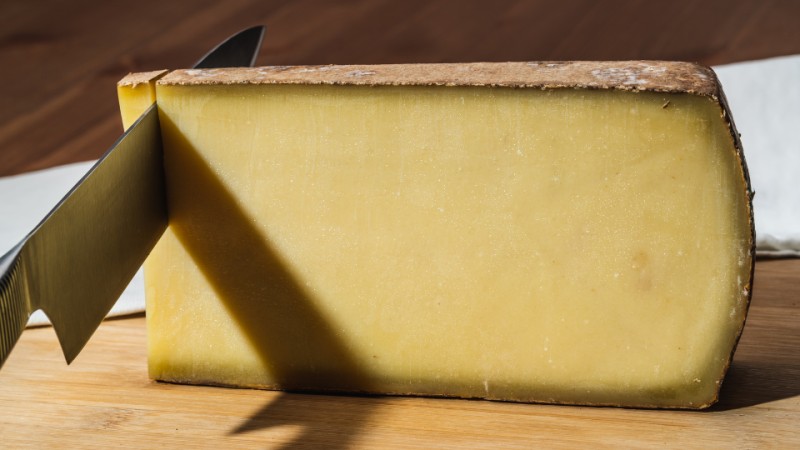Introduction Comte Cheese
Comte cheese is one of the French culinary foods that special place their plates for this cheese because of its long history and distinctive production methods. and excellent flavor profile. we will look into the wonderful history of Comte cheese in this thorough guide, covering its history production process, flavor attributes, culinary uses, and substitutes.
You can also read Cotija Cheese Substitute
History of Comte Cheese
The history of Comte cheese is one of the oldest cheeses in France, with eight centuries of roots. Made with great craftsmanship by artisans in the verdant valleys of franche-comte, Comte cheese has a rich history steeped in tradition. Produced initially by nearby farms as a way to preserve extra milk, comte quickly became well-known for its flavor and consistency.
The process of making comte cheese has been developed and improved throughout the ages, but the dedication to maintaining its originality has not altered. These days, only raw cows milk from French Simmental and Montbeliarde cows, who graze on the nutrient-rich grassland of the Jura mountains, is used to make comte. The cheese is made in traditional “Fruitieres” or cheese dairies” by expert cheesemakers using age-old techniques.
The Flavor Profile
The age-old, painstaking process of making comte cheese calls for the knowledge of expert cheesemakers known as “maitres fromagers” Here is a summary of the essential actions involved in creating this masterpiece.
Milk Sourcing
- Only raw cows’ milk from French Simmental or montbleliarde cows-known for producing milk of the highest caliber are used to make Comte cheese.
- Curdling Using natural rennet, fresh milk is heated until it coagulates, generating curds that are then chopped and swirled to produce whey.
- Pressing and Molding: To remove extra whey and form the cheese into the recognizable big wheels, the curds are gently pressed into molds.
- Salting: The next important step that improves flavor and helps preserve the cheese is to salt the cheese wheels, which can be done by bringing or dry salting them after molding.
Ageing Comte cheese
The young Comte wheels are moved into cellars to age for a minimum of several months to several years. The cheess unique aromas and textures, which range from creamy and mild to rich and nutty, developed during this period.
Culinary Uses and Pairings
The adaptability of chevre renders it a popular component in a wide range of recipes enjoy comte cheese
Cheese Platters
For a classy first course or dessert, present Comte as the star of the show on a platter together with artisanal bread, fruits, and nuts. Its remarkable melting properties and flavor make it a great addition to gratins, fondues, and grilled cheese sandwiches. To add depth and creaminess to your dishes, grate some Comte over spaghetti, salads, and soups.
Wine pairing: A variety of wines, such as Chardonnay, pinot noir, or fruity reds like Beaujolais, go well with the richness of comte.
Nutritional Benefits of Comte Cheese
- High-quality protein is abundant in this food and is necessary for both muscle growth and repair.
- Calcium in Comte cheese encourages healthy teeth and bones.
- Vitamins A, B12, and D are vital for immune system function and general health.
Comte Cheese Substitues
What works well in place of Comte cheese will depend on the particular dish or recipe you’re making as well as your taste preferences. The following are some options to think about.
Gruyere Cheese: Similar to Comte, Gruyere is a nutty, slightly sweet Swiss cheese. It melts easily and is great in gratins, fondues, and sandwiches, among other foods.
Emmental Cheese: Emmental is mild, nutty cheese with a hint of tanginess. It is another type of Swiss cheese. It works well in cheese sauces, quiches, and sandwiches since it melts so beautifully.
Beaufort Cheese: Beaufort is a firm-textured, nutty-flavored French Cheese that resembles Comte in several aspects it works great for melting and is suitable for use in Comte-style dishes.
Appenzeller Cheese: Characterized by a strong robust flavor with hints of herbs and nuts, this Swiss cheese is delicious. it’s a great option for giving soups, cheese boards, and gratins more flavor.
Fontina Cheese: Rich and buttery, fontina is an Italian cheese that goes well with a lot of different foods, it’s great in pizzas, grilled sandwiches, and pasta meals since it melts nicely.
Cheddar Cheese: Cheddar can be used in place of comte in recipes calling for melting or grating, even though it has a stronger, more acidic flavor. It gives hearty meals like omelets, casseroles, and macaroni and cheese a rich flavor.
What Does Comte Cheese Taste Like?
Little comte 4-6 months old mild buttery soft butter-like sweetness and a creamy texture in a fresh cheese a little of tanginess offers a refreshing note.
Aged Comte for more than 7 months has a distinct nutty flavor that is sometimes compared to toasted almonds and hazelnuts. Fruity and smokey hints as it becomes older, more nuanced aspects comte to light you may notice a tinge of smokiness with delicate fruity notes that are frequently characterized as apricot or caramel.

